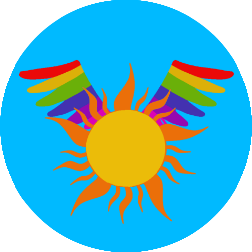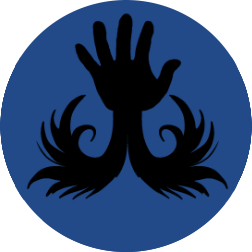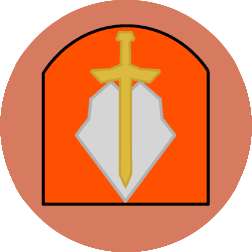| PANTHEON | ||||||||||||||
Geb - (Knowledge, Life, Grave, Order)
Colors: Blue and gold, sometimes green Symbols: Snakes (healer and wellspring of life), ouroboros (lord of secrets), cobra (father of serpents), horned viper (represents his messengers) Image: A golden iaret, dressed in a white tunic and kilt, sometime shrouded, sometimes with a hood or headdress like a cobra, always depicted with eyes closed, sometimes with arms crossed over chest as if in repose Other incarnations: Mother Mountain - imposing ozrut woman with short horns and black hair, either red or blue, holding an ewer Geb (worshiped by humans) - a golden human dressed in white robes and a white hood, holding a golden snake in one hand Ranute - (Tempest, Light, Twilight, Arcana)
Colors: Orange, red, blue and white (colors of the sky), rainbows Symbols: Winged sun (with either one, two or six wings - sometimes with rainbow feathers), winged circlet or crown Image: A golden iaret, dressed in a sheer white sheath dress, usually with arms outstretched, sometimes womanly sometimes slender, one eye green and painted with a kohl wadjet Other incarnations: Father Cloud - an old ozrut, either red or blue, with tall horns, cloudy white hair and beard, tusks, sometimes carrying a large drum or maul The Greatest Flock - haphazardly sketched tumult of all kinds of birds, sometimes just a cluster of wings, riotous colors Ranute (as worshiped in the Jewel Cities) - the sun with many hands descending from it The Drowning Girl - (Death, Grave, Twilight, Order)
Colors: Dark blue, black, white (among ozrut only) Symbols: Her face surrounded by coiling hair, grasping hands Image: A white iaret child with extremely long, curling black hair, sometimes in a white shroud, rarely nude Other incarnations: The White Sister - completely white ozrut girl with long white hair The Lost Child - small muruch girl with very long black hair, always alone with without anything The Drowning Girl (as worshiped in the Jewel Cities) - typical iaret depiction but more obviously drowned, bloated, sometimes decomposing, sometimes with her neck broken Neath - (Light, War, Forge, Peace)
Colors: Orange, red and grey, red and blue (among ozrut only) Symbols: Torch in an open door (lady of the hearth), sword across a fireplace or door (defender), hammer emerging from fire (mistress of the forge) Image: A golden iaret, sometimes in armor and sometimes in a white sheath dress, with an arrow or weapon in one hand and torch in the other, sometimes one side of her face frowning and the other smiling Other incarnations: The Red and Blue (or Blue and Red) Daughter - ozrut with one side of her body red and the other blue, an axe in one hand and torch in the other, often depicted as if she is shouting Neath (as worshiped in the Jewel Cities) - two women back-to-back, sometimes conjoined, one armored and scowling with a hammer, the other in a dress and smiling while carrying a torch The Horizon Walker - (Trickery, Arcana, Death, Knowledge)
Colors: None, black (among ozrut only) Symbols: None (officially), a simple horizontal line representing the horizon (unofficially) Image: None (officially), the outline of a striding man, sometimes with a staff (unofficially) Other incarnations: No-Color - a completely pitch black ozrut man The Bargainer - a ptak (sometimes papuga, sometimes kruk) wearing colorful mismatched clothes The Man at the Crossroads - an aged human beggar in shabby clothes, always depicted as standing at a crossroads Ash - (Nature, Trickery, Twilight, Peace)
Colors: Silver, black and white Symbols: The moon in various phases Image: A grey iaret dressed in a white kilt, usually hunched and furtive or crouched, at least one of his eyes white and painted with a wadjet, sometimes has a bare branch in one hand and a leafed/fruiting branch in the other Other incarnations: Ash (as worshiped in the Jewel Cities) - a grey-furred beastkin dressed in a white kilt, hunched or crouched, wearing a mask to look like an iaret The Tree Under the Moon - a tree, sometimes bare, with the moon caught in its branches Apsu - (Tempest, Knowledge, Trickery, Arcana)
Colors: Blue and white Symbols: Cresting wave (everchanging waters), a spear through a blue circle (the wounded lady) Image: A silver iaret in a white sheath dress, wearing a blue circlet or crown, with a bloody hole in her chest over her heart, sometimes holding a closed scallop shell in one hand, sometimes a net or trident in the other Other incarnations: Apsu (as worshiped in the Jewel Cities) - a black iaret, usually nude and in a provocative pose, with a bloody toothed whole in her chest, sometimes holding an open scallop shell with a black pearl Apsu (as worshiped by the muruch) - a muruch woman dressed extravagantly with a shawl of dangling shells, hair composed of seafoam, in one hand a frond of kelp and in the other a closed scallop shell Other Powers The known earth and beyond holds many mysteries and powers to which mortals might devote themselves. The following are other concepts, creatures, and forces worthy of worship, propitiation, or bargaining with for power. The Star - The star which pierced the heart of the Wounded Lady still burns in her breast like a cancer. It is not of this world, and bleeds terrifying chaos and malignancy in the unseen depths of the ocean. The Absent Royalty - Though it is rare for a tylwyth to speak of it, they had rulers as well, once. Mighty kings and queens held sway over their mysterious homeland. Dream-logic was ironclad law there, powerful enough that its tenets can ring true even in the waking world. Outsiders - Different planes lurk behind the reality of the known earth, inhabited by strange and powerful beings. While they may not be as unreachable and invincible as gods, they still wield potency beyond the ken of mortals. With their ability to perceive the Other Ocean, the apkallu have studied such creatures for ages. Philosophy - Belief, it is said, can move mountains. Whether it is the still unshakeable faith in soldati conquest, or the resolve to enact the will of the proletariat, the souls of mortals can draw strength from defined and shared concepts. The Wind - Frequently spoken of almost as a friend by the tylwyth, the wind is a playful and capricious force in their belief. What power it truly holds is unknown, but it is a strong part of their observable culture. |






